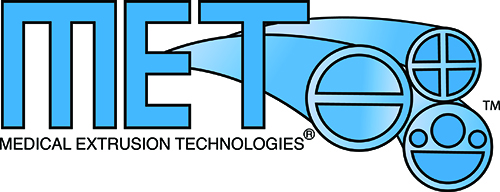Medical extrusion is the backbone of many critical devices. Catheter shafts, IV lines, pump tubing, and protective sheaths are all created through extrusion. The process allows manufacturers to deliver continuous lengths of medical-grade tubing with consistent dimensions. In practice, this means catheter shafts that track accurately, liners that reduce friction with FEP heat shrink, and peristaltic pump tubing that withstands repeated cycles without failure.
Processes That Shape Medical Tubing
Different extrusion approaches create different device outcomes. Single-layer extrusion produces uniform tubing for general fluid transfer. Coextrusion builds multi-layer structures that combine lubricity, strength, and radiopacity in one shaft. Multi-lumen tubing allows simultaneous pathways within a single profile, while multi-durometer stacks balance stiffness and flexibility along the length of a catheter. Profile extrusions create custom geometries for seals and housings. Heat shrink and reflow techniques are often used with extruded liners to create smooth, bonded catheter shafts.
Choosing the Right Polymers for Medical Tubing
The choice of resin dictates mechanical properties, sterilization options, and biocompatibility. Each polymer family offers unique tradeoffs:
Materials for Medical Device Extrusion
| Material | Key Properties | Typical Applications | Sterilization Options |
|---|---|---|---|
FEP / PTFE | Low friction, chemical resistance | Liners, heat shrink sleeves | EtO, gamma, e-beam |
Pebax (TPEE) | Tunable hardness, flexibility | Catheter shafts, balloons | EtO, e-beam |
Nylon 12 | Thin walls, toughness | Catheter layers, bump tubing | EtO, e-beam |
TPU | Abrasion resistance, clarity | Pump lines, jackets | EtO, gamma |
PEEK | High strength, thermal stability | Specialty components | EtO, limited gamma |
Bioresorbables | Time-limited support | Temporary scaffolds, anchors | Application-specific |
Selecting polymers early in development helps avoid delays during validation. Recent focus on PFAS regulations is also reshaping material strategy, with bioresorbable and hybrid constructions gaining traction.
Controlling Tolerances in Medical Extrusion
Precision is the central requirement for OEMs. Outer and inner diameters must hold to tight tolerances, while wall thickness and ovality need to remain stable over long runs. Achieving this level of control depends on die geometry, melt stability, vacuum sizing, cooling profiles, and puller speed.
Inline inspection adds another layer of assurance: laser micrometers track OD and ovality, vision systems catch surface flaws, and ultrasonic or x-ray tools verify wall thickness. Robust control plans with defined sampling, GRR results, and capability data (NIST capability analysis overview) give OEMs confidence that tubing will perform as intended.
Smart Manufacturing and Data-Driven Extrusion
Automation and Industry 4.0 tools are changing how extrusion is monitored. Recipe management and real-time feedback allow operators to adjust parameters before deviations become defects. Machine-learning tools can flag drift, but experienced technicians remain essential when resin variability or secondary processes introduce complexity. For OEMs, data capture shortens DOE cycles and accelerates OQ and PQ, reducing overall time to market.
Regulatory and Validation Considerations
Every extrusion run eventually connects to regulatory submission. Suppliers must support IQ, OQ, and PQ with proper documentation, including certificates of compliance, lot records, and change control. Increasing alignment between FDA’s QMSR and ISO 13485 underscores the need for validated processes.
An experienced partner will provide material data sheets, sterilization compatibility notes, and sample builds that streamline OEM validation efforts. MET supports validation with tensile testing in medical manufacturing and documented process controls.
Design for Manufacturability in Tubing Projects
Drawings and specifications determine whether extrusion runs smoothly. Calling out OD, ID, wall thickness, and ovality with realistic tolerances saves weeks of redesign. Providing sterilization methods, shelf-life targets, and complete stack-up drawings ensures extrusion integrates cleanly with braids, coils, and bonding steps. Early collaboration avoids tolerance stacking and helps OEMs bridge the gap between prototypes and custom catheter manufacturing.
Emerging Trends in Medical Extrusion
The industry is pushing toward microextrusion with smaller diameters and thinner walls for neurovascular and structural heart applications. Hybrid constructions combine layers inline to reduce secondary steps. Inline wall measurement tools are evolving beyond traditional laser OD checks. Surface texturing is being explored to reduce tackiness without additional coatings. Each of these developments opens opportunities for OEMs to build smaller, more capable devices without sacrificing performance.
Extrusion translates material science and process control into tangible device performance. By working with a partner who manufactures in-house, controls tolerances, and supports validation, OEMs gain confidence that their products will meet both regulatory requirements and patient needs.
Looking for extrusion expertise that scales with your program?
Contact Medical Extrusion Technologies to request a DFM review and samples.








Comments are closed